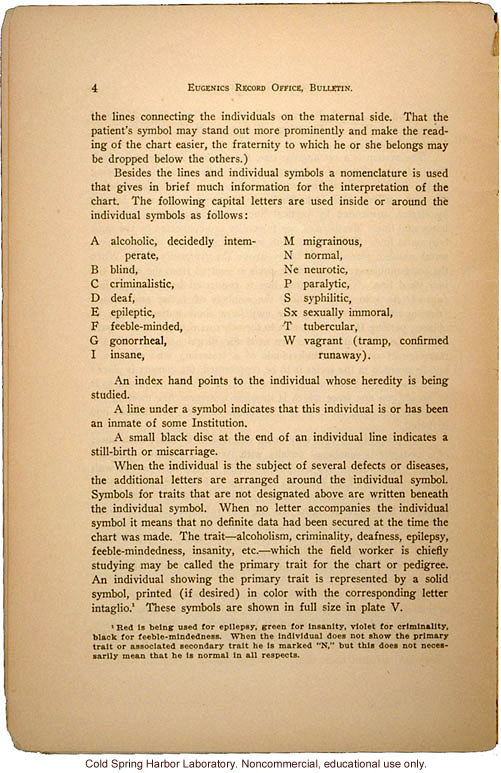4 Eugenics Record Office, Bulletin.
the lines connecting the individuals on the maternal side. That the patient's symbol may stand out more prominently and make the reading of the chart easier, the fraternity to which he or she belongs may be dropped below the others.)
Besides the lines and individual symbols a nomenclature is used that gives in brief much information for the interpretation of the chart. The following capital letters are used inside or around the individual symbols as follows:
A alcoholic, decidedly intemperate,
B blind,
C criminalistic,
D deaf,
E epileptic,
F feeble-minded,
G gonorrheal,
I insane,
M migrainous,
N normal,
Ne neurotic,
P paralytic,
S syphilitic,
Sx sexually immoral,
T tubercular,
W vagrant (tramp, confirmed runaway).
An index hand points to the individual whose heredity is being studied.
A line under a symbol indicates that this individual is or has been an inmate of some Institution.
A small black disc at the end of an individual line indicates a still-birth or miscarriage.
When the individual is the subject of several defects or diseases, the additional letters are arranged around the individual symbol. Symbols for traits that are not designated above are written beneath the individual symbol. When no letter accompanies the individual symbol it means that no definite data had been secured at the time the chart was made. The trait - alcoholism, criminality, deafness, epilepsy, feeble-mindedness, insanity, etc. - which the field worker is chiefly studying may be called the primary trait for the chart of pedigree. An individual showing the primary trait is represented by a solid symbol, printed (if desired) in color with the corresponding letter intaglio.[superior 1] These symbols are shown in full size in plate V.
[footnote][superior 1]Red is being used for epilepsy, green for insanity, violet for criminality, black for feeble-mindedness. When the individual does not show the primary trait or associated secondary trait he is marked "N," but this does not necessarily mean that he is normal in all respects.
[end]


